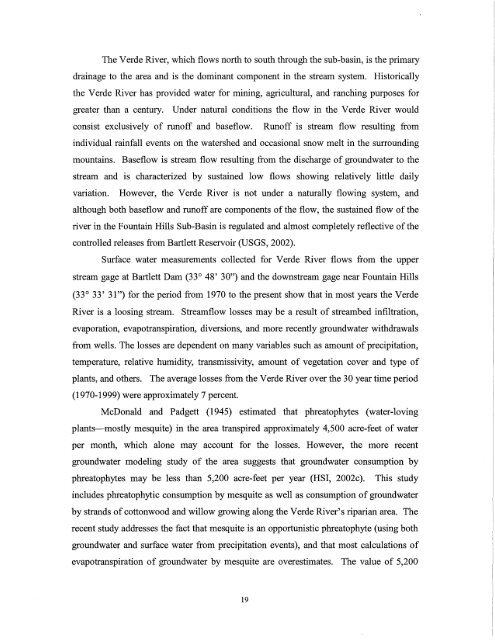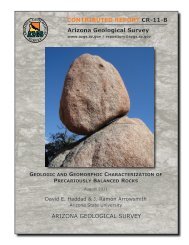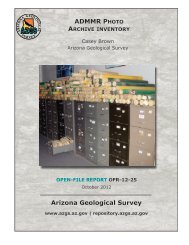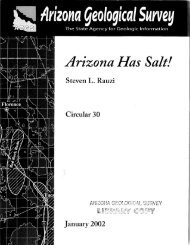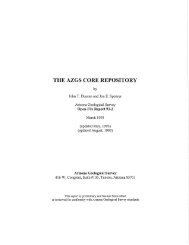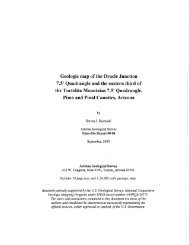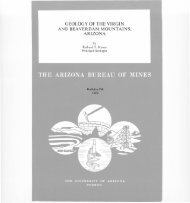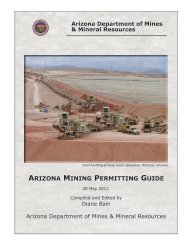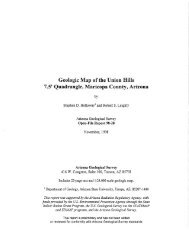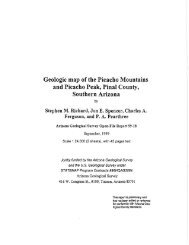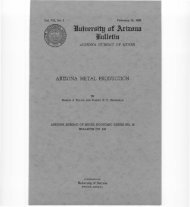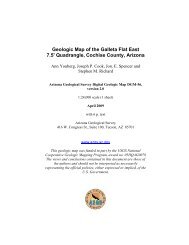Subsurface Geologic Investigation of Fountain Hills - AZGS ...
Subsurface Geologic Investigation of Fountain Hills - AZGS ...
Subsurface Geologic Investigation of Fountain Hills - AZGS ...
Create successful ePaper yourself
Turn your PDF publications into a flip-book with our unique Google optimized e-Paper software.
The Verde River, which flows north to south through the sub-basin, is the primary<br />
drainage to the area and is the dominant component in the stream system. Historically<br />
the Verde River has provided water for mining, agricultural, and ranching purposes for<br />
greater than a century. Under natural conditions the flow in the Verde River would<br />
consist exclusively <strong>of</strong> run<strong>of</strong>f and baseflow. Run<strong>of</strong>f is stream flow resulting from<br />
individual rainfall events on the watershed and occasional snow melt in the surrounding<br />
mountains. Baseflow is stream flow resulting from the discharge <strong>of</strong> groundwater to the<br />
stream and is characterized by sustained low flows showing relatively little daily<br />
variation. However, the Verde River is not under a naturally flowing system, and<br />
although both baseflow and run<strong>of</strong>f are components <strong>of</strong> the flow, the sustained flow <strong>of</strong> the<br />
river in the <strong>Fountain</strong> <strong>Hills</strong> Sub-Basin is regulated and almost completely reflective <strong>of</strong> the<br />
controlled releases from Bartlett Reservoir (USGS, 2002).<br />
Surface water measurements collected for Verde River flows from the upper<br />
stream gage at Bartlett Dam (33 0 48' 30") and the downstream gage near <strong>Fountain</strong> <strong>Hills</strong><br />
(33 0 33' 31") for the period from 1970 to the present show that in most years the Verde<br />
River is a loosing stream. Streamflow losses may be a result <strong>of</strong> streambed infiltration,<br />
evaporation, evapotranspiration, diversions, and more recently groundwater withdrawals<br />
from wells. The losses are dependent on many variables such as amount <strong>of</strong> precipitation,<br />
temperature, relative humidity, transmissivity, amount <strong>of</strong> vegetation cover and type <strong>of</strong><br />
plants, and others. The average losses from the Verde River over the 30 year time period<br />
(1970-1999) were approximately 7 percent.<br />
McDonald and Padgett (1945) estimated that phreatophytes (water-loving<br />
plants-mostly mesquite) in the area transpired approximately 4,500 acre-feet <strong>of</strong> water<br />
per month, which alone may account for the losses. However, the more recent<br />
groundwater modeling study <strong>of</strong> the area suggests that groundwater consumption by<br />
phreatophytes may be less than 5,200 acre-feet per year (HSI, 2002c). This study<br />
includes phreatophytic consumption by mesquite as well as consumption <strong>of</strong> groundwater<br />
by strands <strong>of</strong> cottonwood and willow growing along the Verde River's riparian area. The<br />
recent study addresses the fact that mesquite is an opportunistic phreatophyte (using both<br />
groundwater and surface water from precipitation events), and that most calculations <strong>of</strong><br />
evapotranspiration <strong>of</strong> groundwater by mesquite are overestimates. The value <strong>of</strong> 5,200<br />
19


